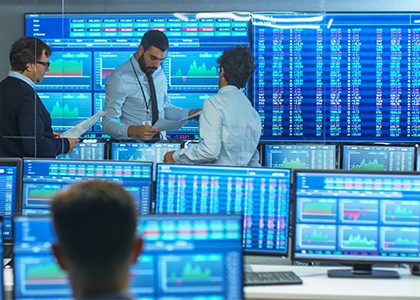As I write this blog (December 24, 2018), the stock market has suffered its worst December since the Great Depression.[1] There are several factors that have caused the market to be more skittish than normal including:
- concerns over future interest rate increases,
- trade tensions with China,
- a slowing economy in 2019,
- Treasury Secretary Mnuchin’s announcement that he contacted the six largest banks in the United States to confirm that they had sufficient liquidity and lending capacity
- concerns that President Trump will replace Federal Reserve Chairman Jerome Powell. (Trump is very unhappy with the increases in interest rates lately and has publicly chastised Powell several times about current Fed policy.),
- the huge decline in oil prices which some view as a precursor to a slowing economy.
Despite all these concerns, it’s important to keep in mind that the economy is still healthy and growing, just not as fast as in previous years. While most economists and analysts expect the economy to slow down in 2019, few expect a recession. The tax cuts passed a year ago resulted in huge growth in corporate profits in 2018.[2] Additionally, the unemployment rate in the U.S. is at the lowest level in 49 years at 3.7%.[3] In part due to the tight labor market, the Labor Department announced that wages grew 3.1% in the last 12 months ending in October 2018.[4] These are all positives for the economy.
In our view, two of the biggest risks in the markets right now are the trade tensions with China and future interest rate increases. Currently, the U.S. is in negotiations with China over current and proposed tariff increases. Trump has called himself “…a Tariff Man” in a tweet. One of the problems we see with tariffs against China is that China doesn’t actually pay the tariff, U.S. consumers do. Look at this example. A company imports a case of widgets from China and pays $1,000. With a 25% tariff, they now pay $1,250. China doesn’t pay it, someone else does. Either the company passes along the additional $250 to their customer or they eat the cost.[5] Another possibility is that companies in the U.S. that produces widgets can now increase their prices to $1,250 per case, matching the cost of importing widgets from China.
The only time the tariffs will affect China is if the supplier can find a cheaper source of widgets from a company outside of China. In our opinion and given China’s track record of being one of the world’s lowest cost producer, the tariffs are unlikely to have a long-term effect on China.
In terms of future rate increases, Fed Chairman Powell, as part of his press conference in December, indicated that instead of three rate increases next year, there would probably only be two increases. He also indicated that if conditions warrant, there could be no increases. However, traders only heard that there would be two rate increases and promptly sold stocks pushing the Down Jones Industrial Average from a 130+ point gain to a 489-point loss.[6] Even today (December 26, 2018), I still do not understand why traders ignored Powell’s statement about being “data dependent” and was willing to forgo any increases in 2019 if conditions warranted.
To further emphasize this point, John Williams, president of the Federal Reserve Bank of New York, in an interview with Steve Liesman on December indicated that the rate increases in 2019 “weren’t a commitment” and that the rate increases discussed are based on their current view of what the economy will look like in 2019. Williams indicated that that the economy is strong and that they are listening to what’s going on in the markets as well with business all over the country.[7] While this interview was going on, the Dow Jones Industrial Average showed a gain of over two hundred points. By the end of the day, nervous traders prevailed, and the Dow ended down over four-hundred and fifty points.[8]
We agree with Warren Buffett that “… Charlie and I continue to believe that short-term market forecasts are poison and should be kept locked up in a safe place, away from children and also from grown-ups who behave in the market like children.”[9] That said, we do not agree with most forecasters that there will be two rate increases next year. If the U.S. economy does slow and other major countries’ economies slow, it is very likely that the Fed will maintain current rates and if necessary, even cut interest rates.
The only issue we have about Treasury Secretary Mnuchin’s calls to the six major banks is that he made it public. The public announcement frightened the markets and gave traders even more to worry about. That wasn’t very wise. There was no reason for him to make these calls public.
Moving forward, we believe that stocks are at least fairly priced and may even be attractively priced. One way to evaluate whether the market or a company’s stock price is high, reasonably priced, or inexpensive is to look at the price earnings ratio. (Forgive the math lesson here.) If a company is trading for $20 per share and will earn $1 per share, the price earnings ratio is 20. If another company is also trading for $20 per share and will earn $2 per share, the price earnings ratio is 10, indicating that an investor is paying less for the second company in relation to its earnings.
In evaluating the current market, analysts’ consensus forecast for 2018 earnings for the S&P 500 index is $162.51 per share.[10] Even if there is no growth in earnings next year, an unlikely prospect, the price earnings ratio of the index is 14.5. In comparison, earlier this year when stock prices were higher, the price earnings ratio was over 18 indicating that the market was considerably more expensive. The lower the price earnings ratio, the less expensive the investment.
Despite a reasonable valuation in the U.S. stock market today, we foresee additional volatility in the near future. In the years before the Great Recession of 2008-09, brokerage firms used to have proprietary trading desks, known as prop desks, where they could trade for their own account. When one of their clients wanted to sell a very large block of stock, the brokerage firm would affect the trade via their prop desk and then sell the shares either on the open market or to their clients over a few hours or days. The firm would take the risk of handling the trade. As part of the Volcker Rule that became effective on December 10, 2013, the prop desks are gone, and firms no longer step in to handle the trades. Additionally, the stock exchanges and over-the-counter markets had specialists and market makers that would step in to stabilize the markets when large orders to buy or sell came in. Since the start of the year 2000, the number of traders on the New York Stock Exchange has gone from about 5,000 traders to fewer than 1,000.[11] This loss of liquidity has resulted in less liquidity and more volatility.
We realize that increased volatility tempts many investors to sell. It’s hard to stomach a yearly decline of over 10% or a decline of more than 20% from the yearly high like we’ve seen this year. By the time you realize the decline has happened, the damage has been done. Too often, short-term oriented investors panic and sell at the lower prices. While it’s understandable to be scared of markets during these declines, it really doesn’t make any sense to sell after a decline. If anything, you should buy. Short of that, do nothing. Good investors take the emotion out of the decision-making process and do the opposite of what most people are doing. Sell when others are recklessly buying at any price and buy when others are panicking and selling at any price. The key is to stick to your plan and rebalance when it is warranted.
[1] https://www.cnn.com/2018/12/18/investing/stocks-worst-december-since-great-depression/index.html
[2] https://www.bizjournals.com/triangle/news/2018/08/30/corporate-profits-soared-in-2q-buoyed-by-tax-cuts.html
[3] https://tradingeconomics.com/united-states/unemployment-rate
[4] https://www.investors.com/news/economy/jobs-report-wage-growth-9-year-high/
[5] https://www.taxpolicycenter.org/taxvox/what-tariff-and-who-pays-it
[6] https://finance.yahoo.com/chart/%5EDJI
[7] https://www.cnbc.com/video/2018/12/21/cnbcs-full-interview-new-york-fed-president-john-williams.html
[8] https://finance.yahoo.com/quote/%5EDJI/history?p=%5EDJI
[9] Warren Buffett in the 1992 Berkshire Hathaway Shareholder Letter
[10] https://www.yardeni.com/pub/yriearningsforecast.pdf
[11] https://www.wsj.com/articles/at-closing-time-the-stock-market-heats-up-like-a-bar-at-last-call-1521038300


